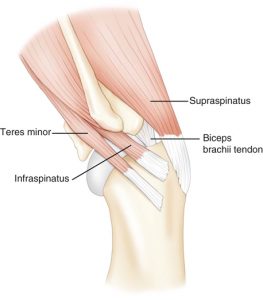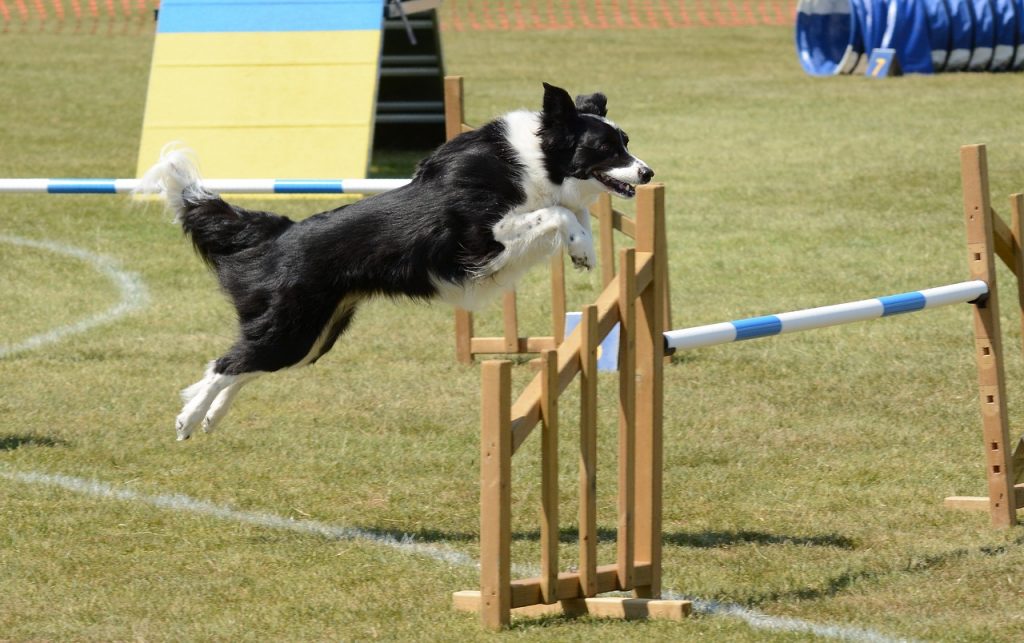Shoulder injuries are reported as one of the most common causes of lameness and decreased performance in agility dogs. While some shoulder injuries are more obvious in nature, any subtle front limb lameness, or unexplained change in performance, warrants further examination.
A survey of 1600 agility dog owners found that shoulder injuries were the most common injury and accounted for 20% of all agility injuries. Border Collies were most likely to be injured, with 15% of their injuries affecting the shoulder. While Border Collies were most likely to be injured, Shetland Sheepdog and Australian Shepherds more frequently injured their shoulders, accounting for 24% and 26% of their injuries, respectively. 27% of all shoulder injuries occurred on the A-frame and 17% occurred on the bar jump. Anecdotally, weave poles are also commonly implicated in shoulder injuries.
Shoulder Injuries in agility dogs include:
- Medial Shoulder Instability (MSI)
- Biceps tenosynovitis
- Supraspinatus tendinopathy
- Infraspinatus contracture
- Osteochondritis dissecans (OCD)
- Teres minor strain
- Triceps strain
Differential diagnoses will also consider the elbow joint and neck.
*While this article focuses on shoulder injuries in agility dogs, the information is also applicable to other sporting dogs. Future articles will provide more details on the individual injuries.
The Dogs Shoulder Joint
The shoulder joint is the connection between the scapula (shoulder blade) and humerus (upper arm bone) of the front limb. There are over 25 muscles that influence the shoulder to produce movement. The shoulder joint is able to withstand large forces and provide excellent mobility, while also maintaining the stability and control necessary for precise movements of the front limb.

The shoulder joint relies on soft tissue structures (e.g. joint capsule, ligaments, muscles) for stability and is an inherently ‘unstable’ joint. Just like in humans, the rotator cuff muscles (supraspinatus, infraspinatus, teres minor, and subscapularis), as well as the bicep, are the primary active stabilizers of the shoulder joint. These muscles work together to produce stability. The shoulder joint also relies on passive capsuloligamentous stabilizers. If these passive structures are deficient, the active stabilizers (rotator cuff muscles) have to work harder.

Signs and Symptoms of Shoulder Injuries
Early signs aren’t necessarily that obvious. In agility dogs you may observe more subtle changes in performance or activities of daily living:
- Reduced stride length (e.g. short striding)
- Missing or declining to jump (e.g. knocking poles with the front limbs)
- Change in jump technique (e.g. head position or lead leg)
- Changes to their turning circle (e.g. not as tight)
- Refusal to weave
- Decreased ability to drive out of a jump / weave
- Subtle changes in behaviour (e.g. less tolerant of other dogs in the house)
- Tires more easily / sleeping more
As an agility dog owner you spend a lot of time watching your dog move. You probably stretch your dog and you may even give your dog a massage. If anything changes and it doesn’t resolve over the course of a few days or week, no matter how subtle, its important you get your dog examined by a rehabilitation professional.
Diagnosis of Shoulder Injuries
Given the often subtle presentation of musculoskeletal injuries it’s important that a thorough physical examination is completed. Pain or discomfort may be elicited by palpation over the soft tissue structures. There may also be associated changes in range of motion (ROM) through the shoulder joint. For example, MSI or biceps long head tear may lead to increased ROM, while infraspinatus contracture may lead to decreased ROM.
While the physical examination will often reveal the most likely diagnosis, scans may be required to confirm the diagnosis. This is especially important in more acute cases, cases that are not responding to conservative care, or if the findings of the scan will alter the immediate treatment plan (e.g. surgery).
Diagnostic Ultrasound
Diagnostic ultrasound can be useful in the differential diagnosis of soft tissue injuries in the shoulder. It is safe and painless, and produces pictures of the inside of the body using sound waves. Ultrasound examinations are available at a relatively reasonable cost and often do not require anesthesia or sedation. The relatively low cost also allows for more frequent and affordable recheck evaluations.
Diagnostic ultrasound is however, not without its disadvantages. Very few Vets are trained to effectively interpret musculoskeletal diagnostic ultrasound. A practitioner without the proper training could misdiagnose an injury on ultrasound, which would ultimately affect your dogs diagnosis and possible treatment outcome. This emphasizes the importance of finding a Vet who is experienced in the application and interpretation of musculoskeletal ultrasound.
X-rays
X-rays assess the bones of the shoulder looking for fractures, degenerative changes, and tumors. They are indicated in acute trauma, or if OCD of the shoulder is suspected. A diagnosis of OCD can be seen as a defect (flattening) present in the humeral head on X-rays of the shoulder.
X-rays don’t assess soft tissue structures so they have limited value in the differential diagnosis of soft tissue injuries in the shoulder. They may however, demonstrate mineralization in chronic soft tissue injuries.
Magnetic Resonance Imaging (MRI)
MRI, in contrast to x-rays, provides excellent soft tissue detail. This includes detail of the muscles, tendons, ligaments and the nerves. MRI is excellent modality in diagnosing soft tissue injuries of the shoulder. It does however come with the need for general anesthesia and is expensive. MRI is often reserved for non-responsive cases.
Shoulder Arthroscopy
Arthroscopic evaluation of the shoulder joint allows for direct observation of all major structures of the shoulder joint, “dynamic” evaluation of soft tissues during shoulder range-of-motion tests, and “palpation” of intra-articular tissues using arthroscopic instrumentation. Arthroscopic examination is considered the gold standard for the diagnosis of MSI. It is also useful in the visualization and diagnosis of other shoulder injuries like biceps tenosynovitis.
Treatment of Shoulder Injuries
Given the sometimes subtle or episodic signs, you may decide to start conservative treatment for shoulder injuries prior to obtaining further scans. The treatment plan needs to include expectations and time frames.
- How long are you going to pursue conservative treatment before further scans or treatment (e.g. surgery) are required?
- What if your dogs symptoms become worse (e.g. increasing lameness)?
- What is required of you, the dogs owner, during this time (rest, play, exercises etc)?
- What if the performance issue returns after resolution?
It is of upmost importance that you fully understand whether your dog should be training and / or competing in agility during this time. While it may be hard to hear because your dog ‘loves’ agility and doesn’t look in pain, you need to understand the risks of further injury if you continue to train and compete.
Agility dogs are often high drive dogs and will continue to work despite an injury.
Conservative treatment may include a mix of traditional Veterinary treatment (rest and NSAID’s), as well as the inclusion of complementary therapies (e.g. manual therapy, acupuncture, laser therapy ) and a rehabilitation program. The conservative treatment will not only address the injured tissue, but also whether other areas are putting more strain on this area.
Conclusion
Shoulder injuries are common causes of decreased performance in agility dogs. A thorough physical examination (and scans, if required) should be completed at the first sign of changes in your dogs performance. Once a diagnosis is formulated, conservative treatment can start with clear treatment goals moving forward.
Conservative treatment may include a mix of traditional Veterinary treatment (rest and NSAID’s), as well as the inclusion of complementary therapies (e.g. manual therapy, acupuncture, laser therapy ) and a rehabilitation program.

